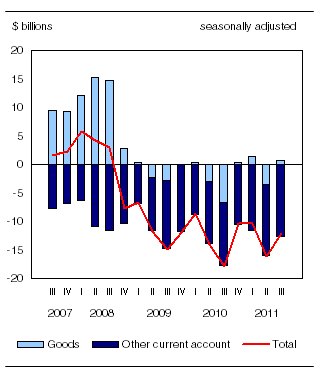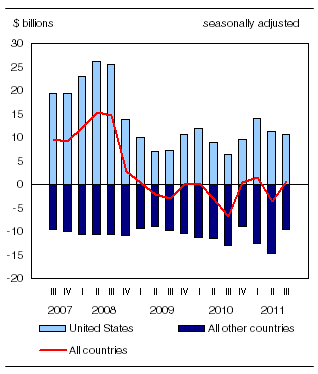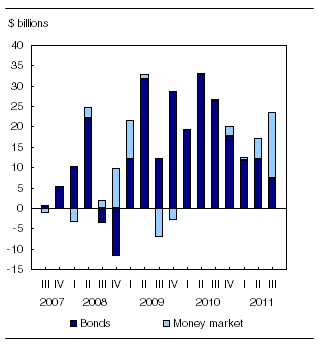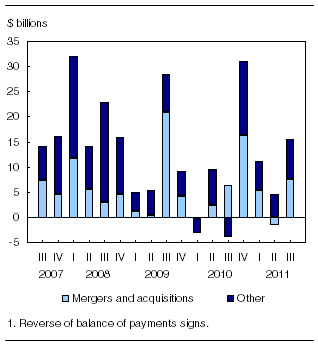Canada's balance of international payments
Archived Content
Information identified as archived is provided for reference, research or recordkeeping purposes. It is not subject to the Government of Canada Web Standards and has not been altered or updated since it was archived. Please "contact us" to request a format other than those available.
Related subjects
-
[an error occurred while processing this directive]
Canada's overall current account deficit (on a seasonally adjusted basis) narrowed $4.0 billion in the third quarter to $12.1 billion, largely the result of higher exports of goods.
Current account balances

Chart description: Current account balances
In the capital and financial account (unadjusted for seasonal variation), foreign portfolio investors continued to supply funds to the Canadian economy, mostly through the acquisition of short-term debt securities. Foreign direct investment activity moderated the overall inflows, as Canadian direct investment abroad exceeded foreign direct investment in Canada for the first time in 2011.
Current account
Goods balance returns to a surplus
The overall balance on the trade in goods was a $0.7 billion surplus in the third quarter following a $3.5 billion deficit the previous quarter. This was led by a rebound in exports, mainly industrial goods and machinery and equipment, while motor vehicles and parts were largely unchanged and energy products weakened further. As a result, the majority of the export strength in the quarter reflected trade with countries other than the United States.
Note to readers
The balance of international payments covers all economic transactions between Canadian residents and non-residents in two accounts, the current account and the capital and financial account.
The current account covers transactions in goods, services, investment income and current transfers.
The capital and financial account is mainly composed of transactions in financial assets and liabilities.
In principle, a current account surplus/deficit corresponds to an equivalent net outflow/inflow in the capital and financial account. In practice, as international transactions data are compiled from multiple sources, this is rarely the case and gives rise to measurement error. The statistical discrepancy is the unobserved net inflow or outflow.
For more information about the balance of payments, consult the "Frequently asked questions" section in the National economic accounts module of our website. The module also presents the most recent balance of payments statistics.
Goods balances by geographic areas

Chart description: Goods balances by geographic areas
Exports of goods were up $4.7 billion to $115.2 billion in the third quarter, the highest level since the third quarter of 2008.
The export of industrial goods, which advanced for a ninth straight quarter, increased $2.3 billion on higher volumes and prices. Most of the gains during the quarter were recorded in precious metals and in metal ores.
Exports of machinery and equipment increased $2.2 billion, mostly on higher volumes. In particular, exports of aircraft rebounded by $0.9 billion in the third quarter after recording their lowest level in more than 10 years in the previous quarter.
Lower exports of crude petroleum more than offset the gains in natural gas and in other energy products as was the case in the previous quarter.
Imports of goods edged up $0.4 billion in the third quarter to $114.5 billion. Automotive products rose $1.2 billion, as a result of higher volumes of imports of cars, trucks and parts. Imports of industrial goods strengthened for a ninth straight quarter, up $0.6 billion on higher prices. However, imports of energy products fell $1.7 billion as both prices and volumes decreased. This was the first decline since the first quarter of 2009.
Trade in services deficit narrows, led by transportation and travel
The trade in services deficit narrowed $0.2 billion to $6.3 billion in the third quarter. In both the transportation and the travel accounts, receipts increased while payments decreased. The reduction in these deficits was slightly offset by a lower surplus on trade in commercial services.
Investment income deficit expands on higher payments
The deficit in investment income went up $0.4 billion to $5.9 billion, as payments outpaced receipts in the third quarter.
Profits on foreign direct investment in Canada were up $0.5 billion as both dividends paid and non-distributed earnings increased, notably in the energy sector. Interest and dividends paid to non-residents were also up (+$0.2 billion), in line with increased foreign holdings of Canadian securities.
On the other hand, profits earned by Canadian direct investors advanced $0.4 billion.
Capital and financial account
Non-resident investment in Canadian securities led by Treasury bills
Foreign investment in Canadian securities focused on money market instruments in the third quarter with purchases of $16.2 billion of these instruments, exceeding the previous high of $9.9 billion in the fourth quarter of 2008. Non-resident acquisitions of short-term securities were mainly in the form of federal government paper, for which foreign holdings increased almost 50% in the quarter.
Foreign investment in Canadian bonds continued in the third quarter with non-residents adding $7.4 billion to their holdings, marking an 11th straight quarter of such investment. However, this was the lowest quarterly acquisition of Canadian bonds during this period.
Foreign investors favoured bonds issued by provincial governments and private corporations in the quarter, both new issues and secondary market acquisitions. These inflows were moderated by a $1.9 billion reduction in foreign holdings of federal bonds, the first such divestment since the fourth quarter of 2008. Non-residents also reduced their holdings of federal government enterprise bonds by $2.1 billion, following five straight quarters of investment. Nevertheless, non-resident holdings of federal bonds at the end of September 2011 were almost three times higher than what they were at the end of December 2008.
Foreign portfolio investment in Canadian debt securities

Chart description: Foreign portfolio investment in Canadian debt securities
Foreign acquisitions of Canadian stocks rose to $4.1 billion in the third quarter. Most of this increase reflected merger and acquisition activity, resulting in the issuance of Canadian shares to former shareholders of foreign firms acquired. This was moderated by the first foreign divestment of Canadian shares on the secondary market in six quarters. Canadian stock prices declined 12.6% in the third quarter, the largest quarterly drop since the fourth quarter of 2008.
Canadian investors continue to focus on foreign equities
Canadian investors purchased $4.6 billion of foreign securities in the third quarter, as the pattern of investment in equity securities and divestment of debt securities continued in 2011.
Acquisitions of foreign stocks were $7.8 billion in the third quarter and mostly targeted the US stock market, led by demand from Canadian pension funds. Most major world equity markets posted losses in the third quarter.
Canadians continued to reduce their holdings of foreign debt securities in the third quarter, but at a slower pace than in the previous quarter. This was led by a $3.0 billion divestment in foreign bonds, mainly from a reduction in holdings of US government securities. Canadians also continued to reduce their holdings of Maple bonds, consistent with the general trend observed since the beginning of 2008.
Outward direct investment exceeds inward direct investment for the first time in 2011
Canadian direct investment abroad was $15.4 billion in the third quarter, the largest such outflow recorded in 2011. This was largely related to cross-border merger and acquisition activity by Canadian financial firms. The US economy accounted for the bulk of this quarterly investment at $11.6 billion, the highest in two years.
Canadian direct investment abroad1

Chart description: Canadian direct investment abroad
Foreign direct investment of $6.2 billion in Canada amounted to the lowest investment since the third quarter of 2010. The majority of the inflows resulted from profits reinvested in Canadian subsidiaries by foreign direct investors. On an industry basis, this was mainly in the energy and metallic minerals sectors of the Canadian economy. Withdrawals of foreign funds from the Canadian financial sector moderated the overall inflows in the third quarter.
Available on CANSIM: tables 376-0001 to 376-0017 and 376-0035.
Definitions, data sources and methods: survey numbers, including related surveys, 1534, 1535, 1536 and 1537.
The third quarter 2011 issue of Canada's Balance of International Payments (67-001-X, free) will be available soon.
The balance of international payments data for the fourth quarter will be released on March 1, 2012.
For more information, or to order data, contact Client Services (613-951-1855; infobalance@statcan.gc.ca). To enquire about the concepts, methods or data quality of this release, contact Denis Caron (613-951-1861; denis.caron@statcan.gc.ca), Balance of Payments Division.
- Date modified:
